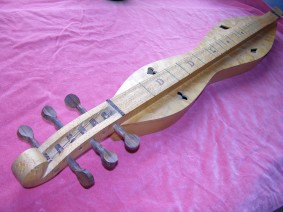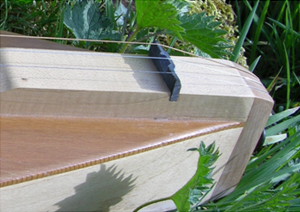Dulcimer Quality Control courtesy of Doug Berch
Common Dulcimer Problems
If you have a difficulty or question which is not answered below, contact me and I’ll do my best to respond. If it is something which may be of interest to others, we’ll add to the list – it would be great for this page to grow organically.
![]()
“I sometimes break a string when tuning/putting new strings on.”
First of all check with your tuner to make sure that you’re not putting undue strain on the strings by tuning them higher than you intended. If not, then look carefully at the nut – the raised piece at the LH end of the fingerboard through which the strings run. If the strings do not run smoothly through this when you tune, or there are sharp edges, strings can be vulnerable to breaking unexpectedly. A simple fix is to use graphite – pencil lead – as a lubricant in each of the string grooves of the nut. A more complete solution will mean careful use of needle files to open up the notches and/or round off angular edges.
![]()
“My tuning pegs seem to be slipping. The dulcimer keeps going out of tune as I play”

Tuners need to be slack enough to turn easily when tuning, but stiff enough to stay where you placed them. This is a tricky compromise to achieve. Most mechanical tuning pegs – geared or friction – have a screw in the end of the button so you can tighten the mechanism with a screwdriver. BUT, be careful not to over-tighten them.
Wooden pegs are a law unto themselves and can be spooked by the slightest knock or by changes in their immediate environment, e.g. increased heat or moisture. Secure them by pushing them hard into the pegbox as you turn – as if you were pushing and turning a screwdriver to tighten a screw. If they continue slipping, use a proprietary peg paste (sparingly) or simply chalk.
![]()
“One of the twin melody strings keeps slipping out from under my fingers when I’m playing”
The easy answer is to remove one permanently – it will make little or no difference in the volume and you may find you prefer a single melody string, particularly for fingerstyle or chord/melody playing. If you want to persist with two, then you can consider using heavier, less floppy strings; or re-cutting the slots in the nut (and possibly bridge) to bring the string pair closer together. This may be something best left to your local instrument repairer/luthier.
![]()
“I’m not happy with the intonation. One string seems to go sharp as I play into the second octave”
 If this has been happening for a while and it’s confined to one string, then it’s most likely to be either the size of string you’re using or the bridge (the raised piece at the RH end of the fingerboard, over/through which the strings pass before being anchored). Most dulcimer bridges have the break points (the highest point over which the strings pass) in a line, making the vibrating length of each string the same. To play perfectly in tune for any given scale, each string size and each tuning requires a slightly different vibrating length…which is clearly impractical. So makers come up with a bridge which is an acceptable compromise for the most common string sizes and tunings. If you play almost exclusively in either DAA/DAG (1:5:5 or 1:5:4 tuning) or DAD/DAC (1:5:8 or 1:5:7 tuning) – and the intonation for your favoured string setup is poor generally – then it might be worth having a so-called compensated bridge made (see picture on right). This has different break points for each string – typically in DAD, the thicker middle string requires a break point up to 1mm to the right of the thinner melody string, for example. Bridges are usually straightforward and cheap to make – and can improve the sound generally, if they are made of better quality material than the original. BUT, you may lose some flexibility should you choose to try different string sizes and tunings in the future. AND, if it’s only one string, you might prefer first to experiment with a different size or make….
If this has been happening for a while and it’s confined to one string, then it’s most likely to be either the size of string you’re using or the bridge (the raised piece at the RH end of the fingerboard, over/through which the strings pass before being anchored). Most dulcimer bridges have the break points (the highest point over which the strings pass) in a line, making the vibrating length of each string the same. To play perfectly in tune for any given scale, each string size and each tuning requires a slightly different vibrating length…which is clearly impractical. So makers come up with a bridge which is an acceptable compromise for the most common string sizes and tunings. If you play almost exclusively in either DAA/DAG (1:5:5 or 1:5:4 tuning) or DAD/DAC (1:5:8 or 1:5:7 tuning) – and the intonation for your favoured string setup is poor generally – then it might be worth having a so-called compensated bridge made (see picture on right). This has different break points for each string – typically in DAD, the thicker middle string requires a break point up to 1mm to the right of the thinner melody string, for example. Bridges are usually straightforward and cheap to make – and can improve the sound generally, if they are made of better quality material than the original. BUT, you may lose some flexibility should you choose to try different string sizes and tunings in the future. AND, if it’s only one string, you might prefer first to experiment with a different size or make….
![]()
“I find the action too high on my dulcimer and I can’t press down hard enough on the frets to produce clear notes.” “My dulcimer buzzes on some notes, particularly when I play it hard”
Two sides of the same coin and each worth a whole chapter on their own, but this is the short version. Try different string sizes: lighter, if you find the strings difficult to press down; heavier, if you find them too sloppy and buzzy when you play hard. If this doesn’t solve the problem, then you will need to delve deeper. A high action can of course be lowered, usually at both nut and bridge. This requires care, reducing the height by very small increments each time, or you may find the strings begin to buzz. If the dulcimer buzzes on just a few notes, perhaps only on one string, the action can be too low at the nut and/or the bridge. OR, it can be individual frets which are slightly raised above their neighbours. All of these have relatively simple solutions, but the initial diagnosis is complicated and perhaps best left to professional repairers.
![]()
“Oh dear, I seem to have had a mishap with my dulcimer…”
First, don’t panic! Virtually everything can be repaired on a relatively simple instrument like the dulcimer.  Broken a string? Not a problem, just ensure you always have at least two sets of spares available. Broken a tuning peg? Usually a straightforward job, but you may need a full replacement set unless it’s a well-known brand. For replacement sets click HERE or give me a ring. Ding on the top? Shallow depressions in softer wood can often be raised by applying a damp cloth and heating the area (through the cloth) using a hot soldering iron or similar. Others swear by a dab of tung or linseed oil to swell the damaged wood. Cracks or splits can almost always be repaired, even where some broken material has been lost. Cracked surfaces are brought together, reinforced with wooden “cleats”, glued and clamped, often using strong magnets. Careful re-building of the finish can leave the break almost undetectable and the instrument will play as well as ever. Unless you’re an experienced woodworker, however, better not to try this at home! Get friendly with a local luthier or instrument repairer and get a realistic cost before you proceed.
Broken a string? Not a problem, just ensure you always have at least two sets of spares available. Broken a tuning peg? Usually a straightforward job, but you may need a full replacement set unless it’s a well-known brand. For replacement sets click HERE or give me a ring. Ding on the top? Shallow depressions in softer wood can often be raised by applying a damp cloth and heating the area (through the cloth) using a hot soldering iron or similar. Others swear by a dab of tung or linseed oil to swell the damaged wood. Cracks or splits can almost always be repaired, even where some broken material has been lost. Cracked surfaces are brought together, reinforced with wooden “cleats”, glued and clamped, often using strong magnets. Careful re-building of the finish can leave the break almost undetectable and the instrument will play as well as ever. Unless you’re an experienced woodworker, however, better not to try this at home! Get friendly with a local luthier or instrument repairer and get a realistic cost before you proceed.

